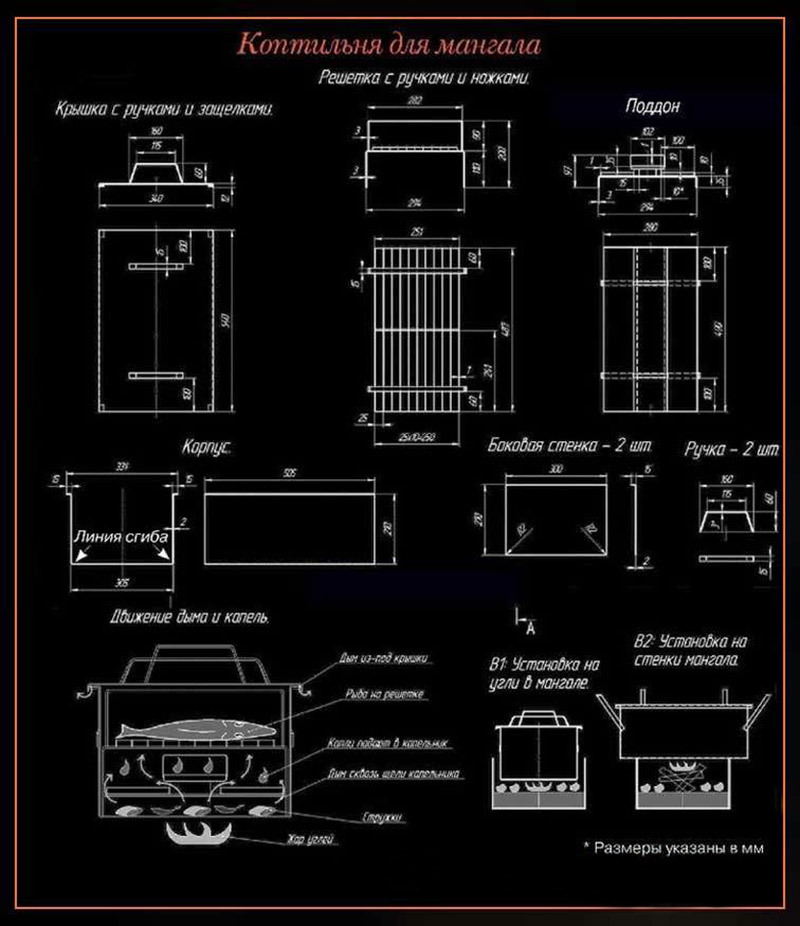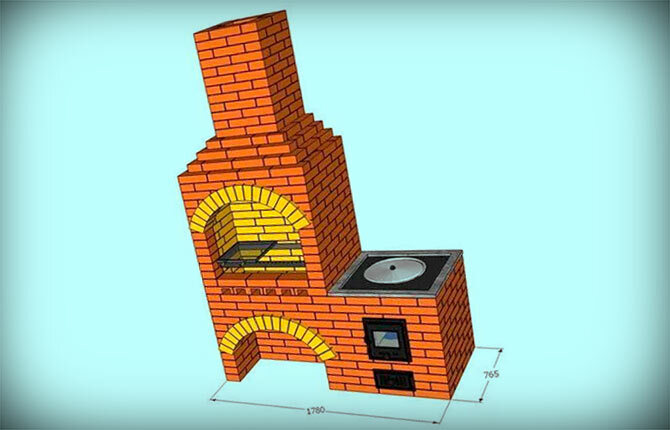CorrectThe application of decorative bark beetle plaster provides a beautiful textured finish. This technology is used to decorate facades and interior walls of buildings for various purposes.
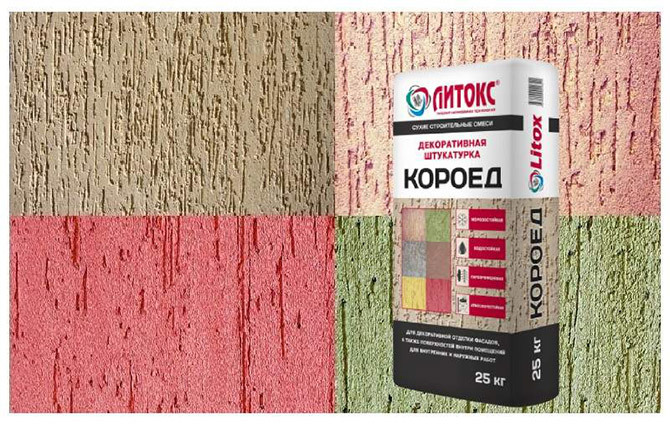
The content of the article:
- Features of the bark beetle plaster composition
- Advantages and disadvantages of bark beetle plaster
-
Types and composition
- Acrylic
- Mineral
- Silicone
- Silicate
- Plaster
- Application Tools
-
How to apply decorative bark beetle plaster
- Step 1. Surface preparation
- Step 2. Preparing the mixture
- Step 3. How to make bark beetle plaster with your own hands
- Step 4a. Manual application method
- Step 4b. Mechanized plastering option
- Step 5. Creating a textured surface
- Step 6. Painting
- Plaster consumption
- Main mistakes when applying bark beetle
Features of the bark beetle plaster composition
The surface finish plastered using a method called “bark beetle” resembles wooden planes worn away by insects.
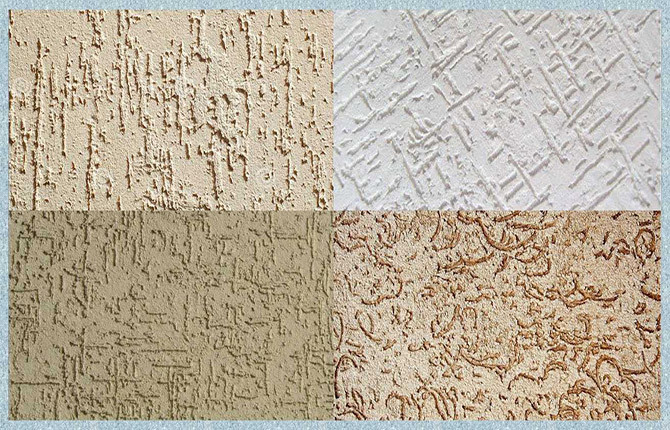
When applying a decorative type of plaster, the formation of such a relief is determined by the inclusion of the filler in the form of solid crumbs into the viscous mass. Grooves imitating the passages of woodworms appear during the grouting operation.
The depth and expressiveness of the resulting relief patterns depend on the size of the fractions.
Larger (2.5–3.0 mm) inclusions are suitable for facades exposed to many external factors (sudden temperature changes, moisture, wind, sunlight, etc.).
Decorative varieties of bark beetle plaster, used for finishing surfaces inside buildings, contain smaller (up to 1.5–2.0 mm) grains.
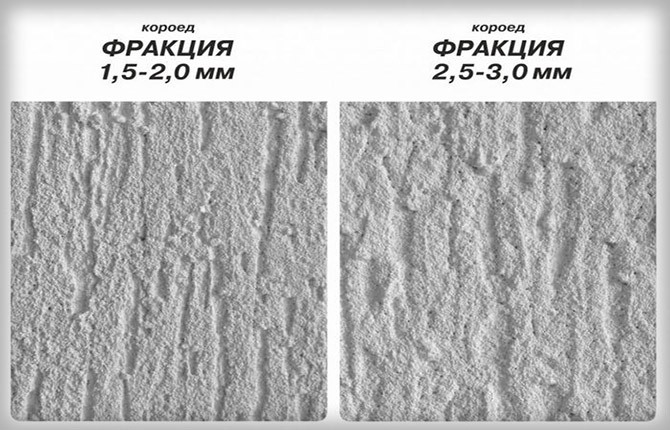
Depending on the composition, before application you need to take into account that among the decorative types of “bark beetles” you can select the following options:
- Interior. This plaster is intended only for interior decoration. It is characterized by low strength indicators.
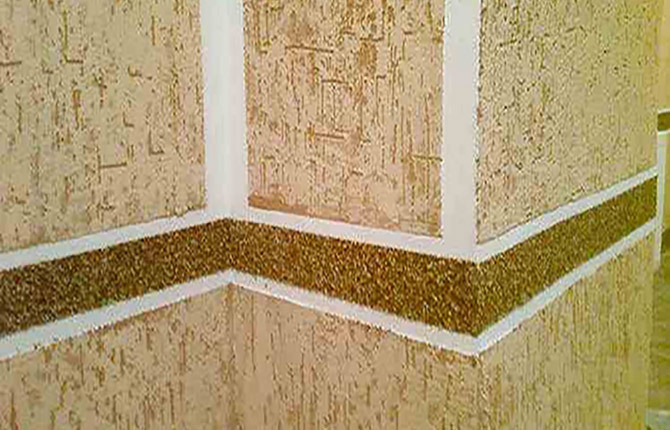
- Facade. This plaster is used for decorative finishing of the external planes of buildings using the “bark beetle” technique. Characterized by increased strength and resistance to UV rays. Facade plaster does not collapse under the influence of temperature fluctuations, moisture, and wind.
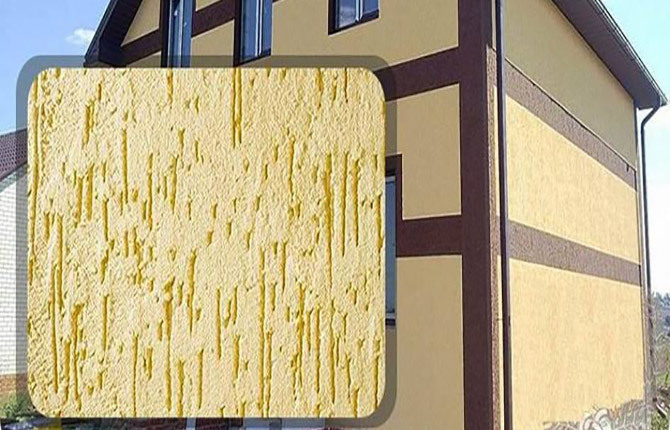
- Universal. Combines the properties of the two previous decorative types. Suitable for application inside and outside houses.

Advantages and disadvantages of bark beetle plaster
The attractive decorative appearance of plaster, known as “bark beetle,” leads to the frequent use of this technique when decorating walls.
Before application, you need to analyze the pros and cons of the popular finishing material.
Advantages of bark beetle plaster:
- has an unusual decor;
- creates, due to the different arrangement of roughness, an imitation of stone, brick, leather;
- allows you to form bas-reliefs;
- does not contain components harmful to health;
- does not require complex care;
- the plaster that has dried after application can be painted;
- demonstrates long-term (up to 15 years) preservation of decor;
- exhibits resistance to fire, moisture, damage by rodents and insects, and mold;
- after applying the decorative plaster composition “bark beetle”, a breathable, vapor-permeable coating with high thermal insulation properties is obtained;
- Suitable for rooms with excessive humidity.
Flaws:
- it is difficult to repair damaged areas, since it is not possible to accurately select the shade and decorative pattern in the “bark beetle” style;
- There are problems associated with uniform coloring of relief surfaces.
Types and composition
Decorative plaster mixtures with an unusual “bark beetle” texture vary in composition. The following options exist.
Acrylic
The base of this decorative elastic plaster is acrylic resins. The mass is sold in finished form. Universal compositions show good durability after application externally to façade surfaces and internally. There are already painted compositions that allow you to immediately buy decorative material of the desired shade.
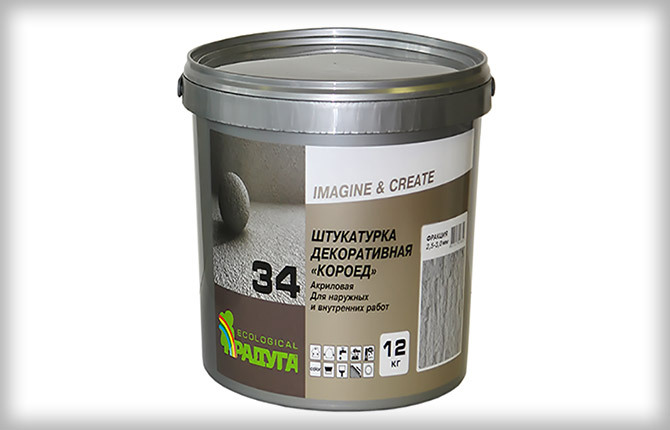
Advantages of the acrylic plaster variety “bark beetle”:
- high frost and moisture resistance;
- good ductility;
- resistance to temperature fluctuations.
Minuses:
- sometimes cracks appear on the façade finish;
- fades under the sun's rays.
After applying acrylic plaster, a wear-resistant decorative “bark beetle” coating is obtained. Accent areas of walls are often decorated using this technique.
The filler is marble chips.
Mineral
This decorative bark beetle plaster is made in the form of a cement-based powder. A plastic mixture is used for applying to facades and decorating interior walls.
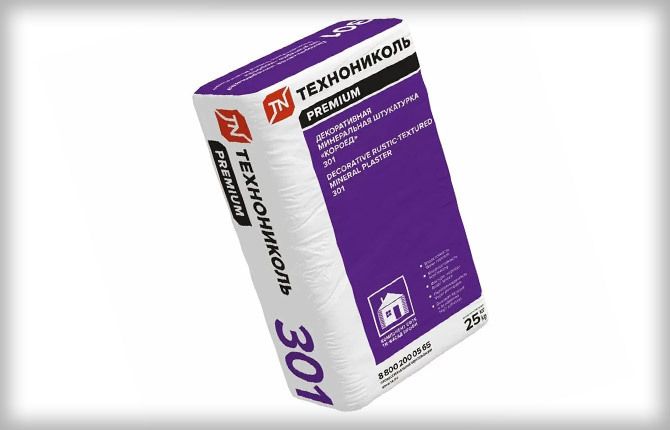
Advantages of mineral plaster:
- low price;
- versatility;
- good resistance to ultraviolet exposure;
- Can be used for application to walls in rooms with high humidity levels.
Minuses:
- not a very wide range of colors;
- the need for dilution before applying the powder with water in compliance with the proportions recommended by the manufacturer;
- strength gains gradually;
- afraid of vibration;
- cracks when the house shrinks.
If they practice applying a mineral decorative mixture to the facade in sunny weather, the decorated areas are covered with plastic film, which prevents the appearance of cracks. It can take up to 4-5 days to dry.
Silicone
This decorative type of plaster is based on silicone resins. Manufacturers offer a mixture that allows you to create a “bark beetle” relief in a ready-to-apply mixture.
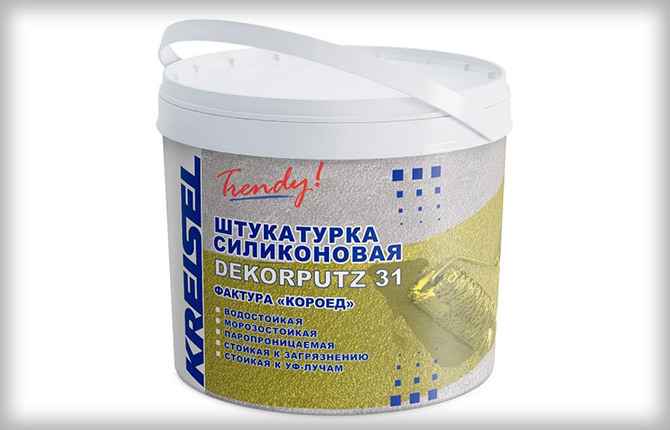
Advantages of silicone plaster:
- the highest elasticity index among decorative analogues;
- variety of shades;
- long service life;
- high impact resistance;
- preservation of decor under sunlight;
- frost and moisture resistance.
Minus silicone plaster mixture with a “bark beetle” texture is considered high in cost.
Silicate
The basis for the production of this decorative type of plaster is liquid glass. You can buy it for application in the form of a ready-made paste and a dry mixture.
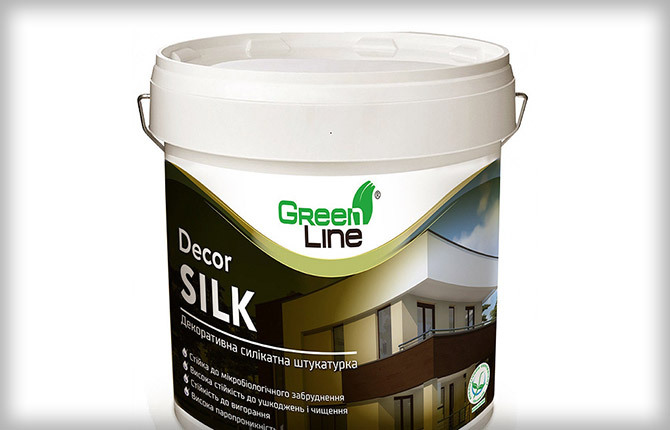
Advantages of silicate coating “bark beetle”:
- increased moisture resistance;
- strength;
- fire safety;
- resistance to possible mechanical damage;
- durability
- preservation of decorative characteristics when exposed to UV rays.
Flaws:
- cracks appear due to vibrations;
- You cannot give the desired shade by introducing color.
When applying silicate mass, harmful compounds can enter the air, which determines its primary use for forming the “bark beetle” texture on the outside of facades.
Plaster
Application of plaster produced on a gypsum base in powder form is possible mainly on internal surfaces. The resulting decorative relief “bark beetle” is painted after the coating has dried.

Advantages of gypsum plaster:
- easy grinding of the mass after application due to its high plasticity;
- vapor permeability of the coating;
- good thermal insulation;
- environmental friendliness;
- rapid hardening;
- minimal shrinkage;
- fire safety;
- resistance to temperature fluctuations.
Minuses:
- not a high level of moisture resistance;
- the appearance of damage under severe mechanical stress.
Application Tools
If you plan to get a “bark beetle” pattern on the surface to be designed after applying the decorative plaster mixture, you need to prepare the appropriate tools:
- Trowel. Needed for applying prepared decorative plaster.
- The grater is plastic. Allows you to create a relief texture characteristic of the “bark beetle” technique.
- Putty knife. Used for collecting plaster mass and transferring it to a trowel.
- Roller. It is useful for applying a primer, as well as for painting surfaces that have dried after plastering.
- Plastering falcon. Used when finishing large surfaces.
- Container for solution. Required if the plaster was purchased in powder form.
- Construction mixer, drill with attachment, wooden spatula. These devices are needed when mixing the solution.
When working, you will need brushes, rags, usually masking tape, sandpaper. When finishing large surfaces, you can use a spray gun.
How to apply decorative bark beetle plaster
Decorative plaster compositions are used for application to vertical planes with a solid structure. The rough base can be brick, cinder block or stone masonry, concrete, or plasterboard.

To obtain the “bark beetle” texture, you need to perform several operations sequentially.
Step 1. Surface preparation
Bark beetle plaster will attract with its decorative appearance if, before applying it, the preparation of the surface to be designed is carried out correctly. It includes several stages:
- Remove old finishes. You need to remove wallpaper, tiles, and clean the surface from paint or peeling plaster.
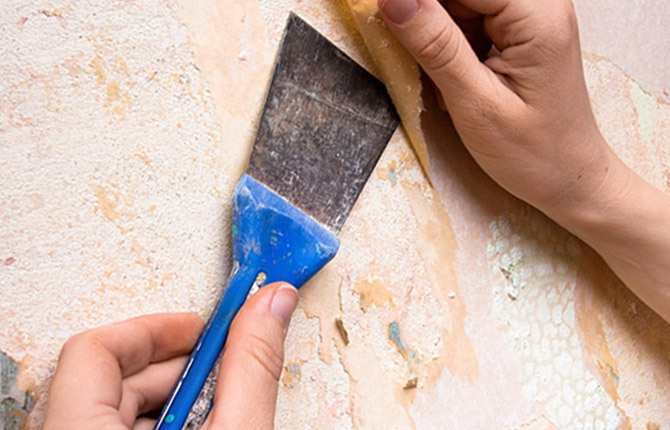
- Check with a rule (you can take a long construction bubble level) the evenness of the base. Identify chips, cracks, and potholes.

- Defects are eliminated by plastering the walls with cement mortar.
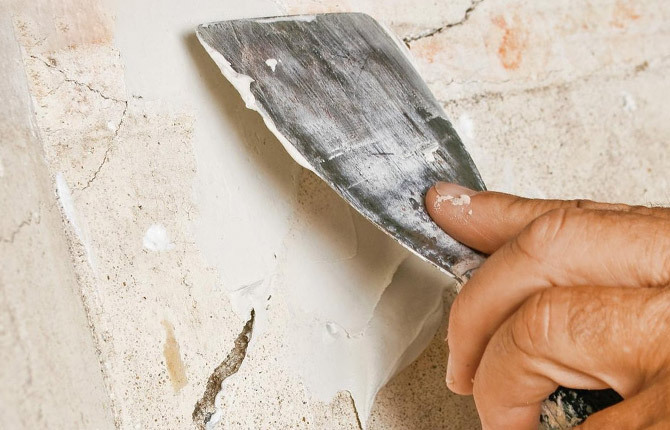
- After drying, sand with sandpaper.
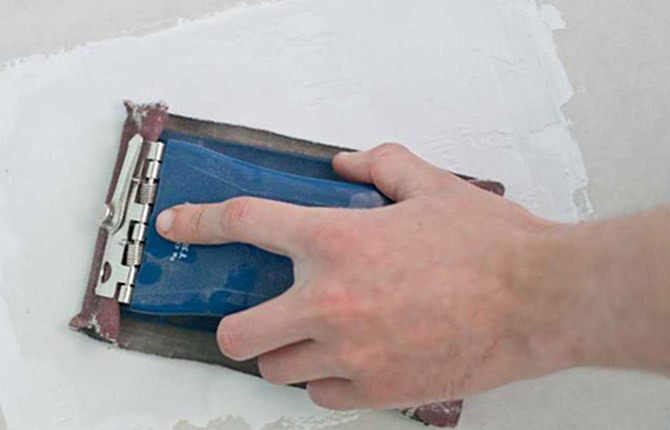
- Clean the walls from dirt and dust with a damp cloth or soft brush.
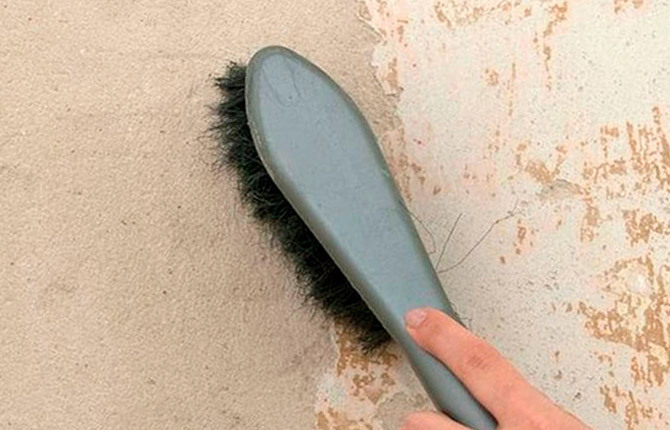
- If oily traces are found, they are removed by distributing household degreasers.
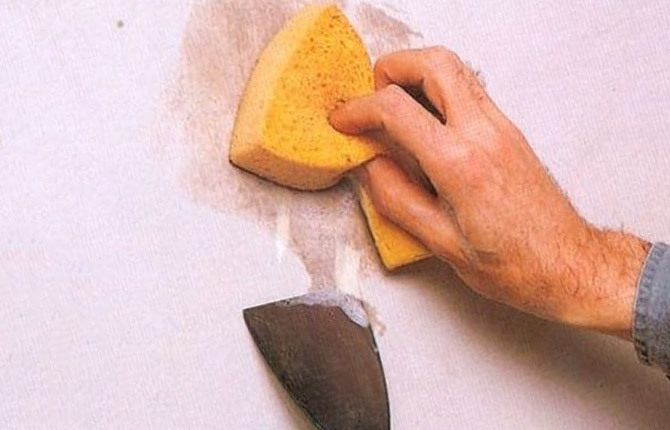
- Using a roller, the surfaces are primed. In hard-to-reach places, coat the walls with a brush. After drying, reapply the primer.
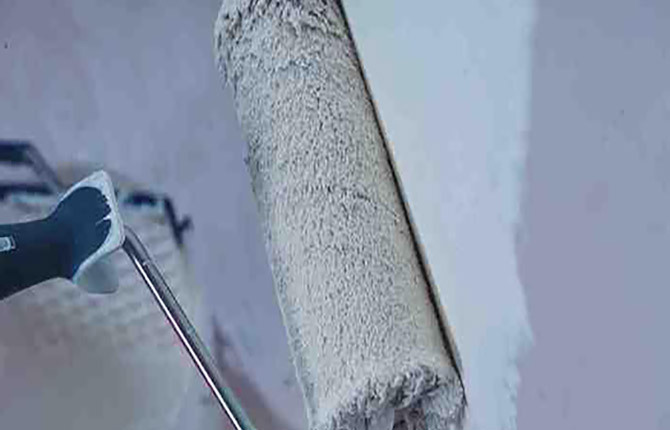
When choosing a primer, study the composition. It should include quartz sand. A silicate primer is used under the decorative “bark beetle” coating based on liquid glass. The shade of the primer should match the color of the final plaster finish.
Step 2. Preparing the mixture
If the decorative variety of bark beetle plaster was purchased in a ready-made form, it should be thoroughly mixed throughout the entire volume immediately before application. Achieve uniformity of the elastic mass.
To prepare a dry plaster mixture, you must first study the instructions indicating the proportions of water and powder. Sequence of operations:
- Pour water into the container. Its temperature is +12–20 °C.
- Measure out and pour the dry mixture into the liquid.
- If necessary, color is introduced.
- Stir the decorative composition until smooth.
- Leave the mixture for 10 minutes. Then it is mixed again.
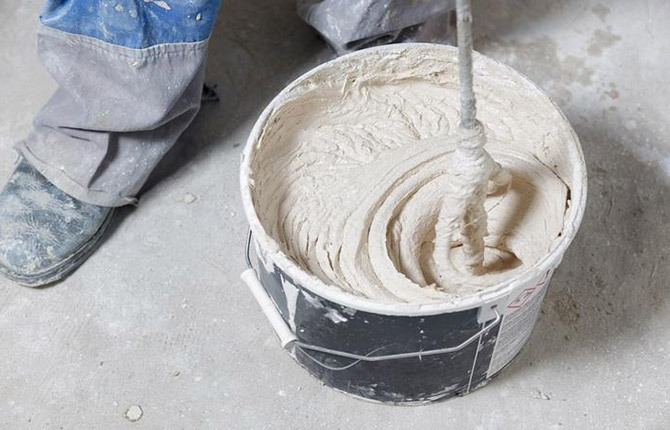
Proceed immediately to applying plaster to the surface. You should prepare such a volume that you can distribute it before the mass begins to set. This parameter is reflected in the instructions.
If you use ready-made bark beetle plaster, then put the required amount in a separate container. The rest of the mass is hermetically sealed.
Step 3. How to make bark beetle plaster with your own hands
To apply decorative plaster of the “bark beetle” variety, you can prepare it yourself at home.
You need to prepare a dry plaster mixture (mineral, gypsum) and stone chips.
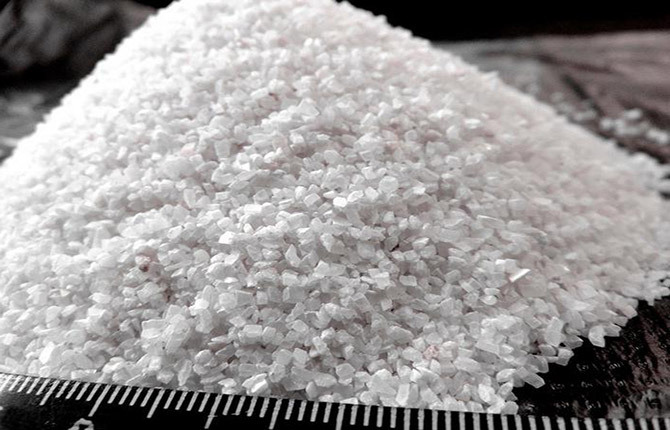
Small fractions are taken for internal work. The role of a plasticizer is assigned to PVA glue. The ratio of stone chips to liquid is 1:10.
Subsequence:
- According to the instructions, measure out the required amount of dry plaster. The volume of water is increased slightly.
- Pour the powder into the container.
- Pour in some water. Stir.
- Add crumbs.
- Dilute with a small amount of PVA water. Pour into the mixture.
- While stirring, add the remaining water. Control the density of the solution to obtain a “bark beetle” structure. If required, add more liquid.
Check the resulting plaster by applying it to a small section of the wall. If the decorative “bark beetle” design is not very expressive, add more crumbs.
Step 4a. Manual application method
Decorative plastering is carried out with the preliminary installation of beacons in a situation where a noticeable curvature of the walls is identified. When the surface is well leveled, apply the prepared bark beetle mass without beacons.
This work is done by sequentially filling small areas of about 1 square meter. m.
The basic technology for applying plaster involves moving from bottom to top. The direction of operations comes from the corner. After finishing the first row, they move up to the next.
The mass is taken from the container with a spatula. Place it on a trowel, which is used to apply it to the wall with one stroke. The remains are thrown into a container. The mixture in it is stirred several times during operation.
After completing the first pass, level the plaster with a spatula. The material remaining on the tool is not suitable for further work, so it is cleaned into a separate container. The thickness of the layer is made equal to the largest size of stone granules in the composition.
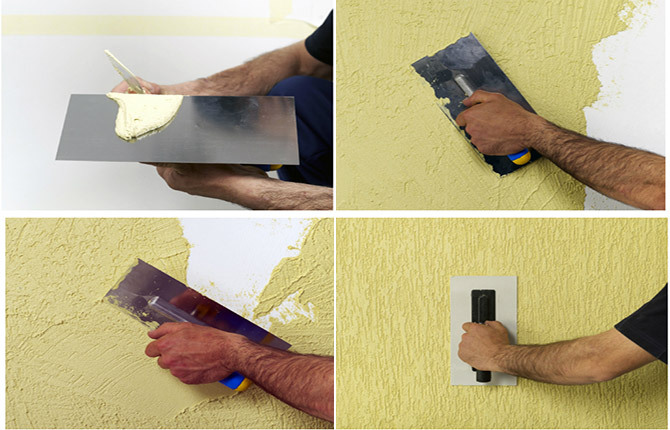
Wait 5–10 minutes until the “bark beetle” texture is formed. Slightly dried decorative plaster should not stick to the palm when touched.
Step 4b. Mechanized plastering option
Often a large amount of plastering work is required, for example, for the exterior decoration of walls or surfaces inside an industrial building. In such a situation, special equipment is used.
The primer mixture is distributed onto the cleaned and prepared surface with a spray gun. After drying, decorative plaster mass “bark beetle” is applied automatically. The device nozzle is kept at a short distance from the plane. The plaster supplied under pressure is distributed evenly.
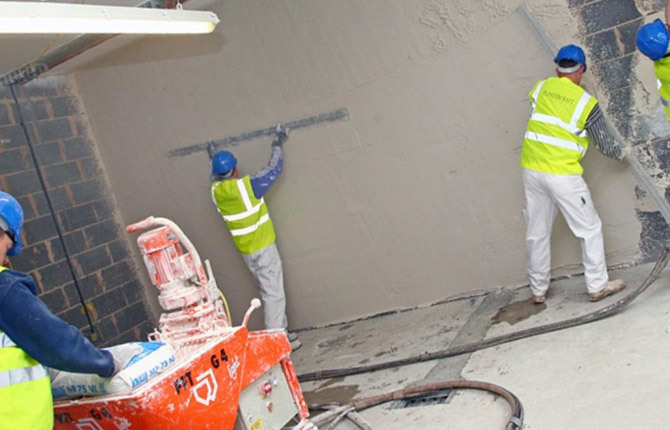
Advantages of the mechanized method:
- applying an even thin layer to reduce material consumption;
- acceleration of work by almost 4 times;
- obtaining high adhesion of plaster to the rough plane;
- eliminating the formation of joining seams due to the continuous application process;
- absence of air bubbles and foreign inclusions in the decorative “bark beetle” mixture.
It must be taken into account that the rapid application of the plastic composition ensures its uniform drying. This prevents the appearance of cracks.
After mechanized plastering is completed, a textured pattern characteristic of the decorative bark beetle variety is created manually.
Disadvantage mechanized technology recognizes the impossibility of using bulky equipment at any facility.
Step 5. Creating a textured surface
When the decorative layer of plaster dries a little (about 10 minutes after application), begin to form the “bark beetle” texture.
This technology consists of performing movements with a float on the wall in the desired directions. Due to the solid grains present in the composition, grooves are formed that fit into the pattern.
There are several variants of the “bark beetle” texture:
- Rain. The grater is moved in one direction (horizontal, diagonal or vertical). Smooth grooves are obtained in the appropriate direction.
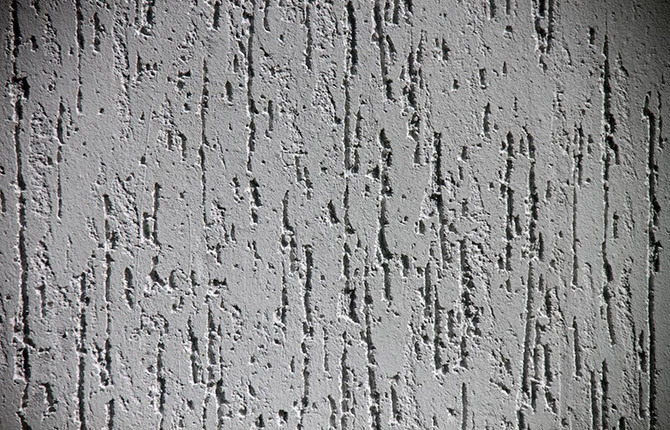
- Carpet. Alternate the vertical and horizontal direction of movement of the grater. The grooves form a cross-shaped relief, reminiscent of a carpet weave.
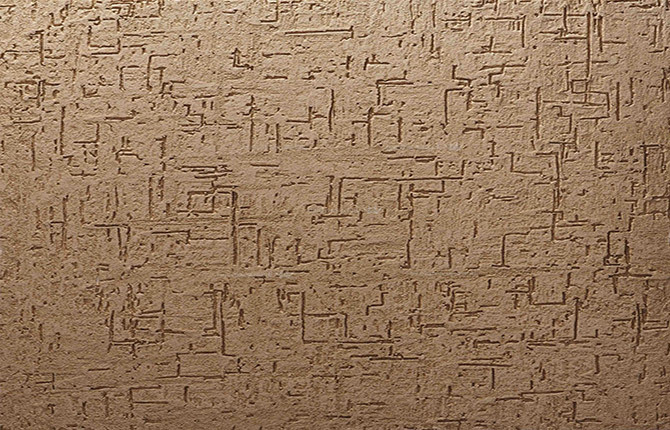
- Crosses. Movements similar to the “carpet” pattern are made alternately in a diagonal direction. Markings are applied first so that the lines are straight.
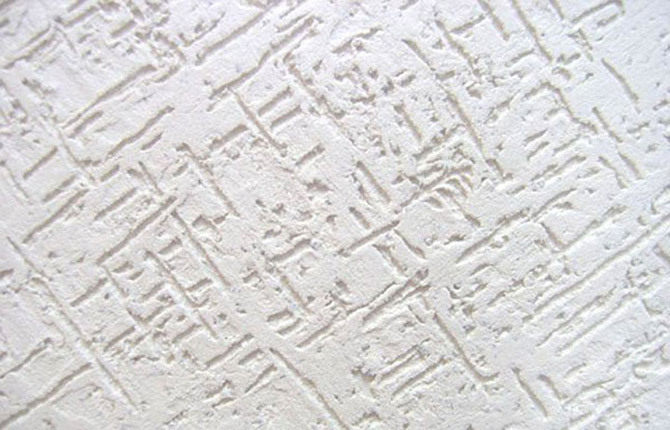
- Lamb. Move the grater around the circle, maintaining its small radius. From the grooves, rounded curls are obtained, imitating curly sheep's wool.

- Woodworm traces. When working, rotate the grater randomly while moving.
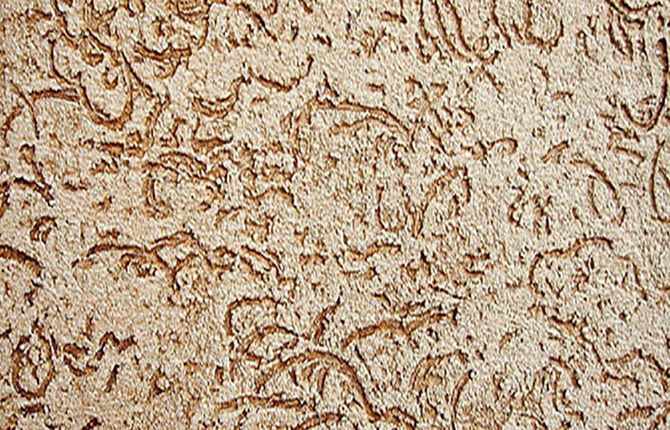
When the decorative relief “bark beetle” is completed, wait for 30 minutes. Finish applying the plaster by smoothing out any sharp bumps remaining on the surface with a float. At this stage, you should not press the tool too hard to preserve the pattern.
Step 6. Painting
Before finishing, the decorative plastered surfaces must dry thoroughly. They are guided by the time specified in the manufacturer’s instructions. Painting the bark beetle relief is easy to do with your own hands if you follow a few rules:
- For internal surfaces, water-based or acrylic paint is used;
- facades must be coated with weather-resistant compounds, for example, water-dispersion based on acrylic, silicate, silicone, matching the applied plaster;
- the coloring pigment can be introduced directly into the plaster mixture when preparing it before application.
Disadvantageintroducing the color into the mass is difficult when choosing a shade if you have to decorate a large wall using the “bark beetle” technique.
Painting methods:
- More often, a paint of one tone is applied with a roller to a decorative layer of plaster with a “bark beetle” texture. Deep grooves in this situation are tinted with a brush.
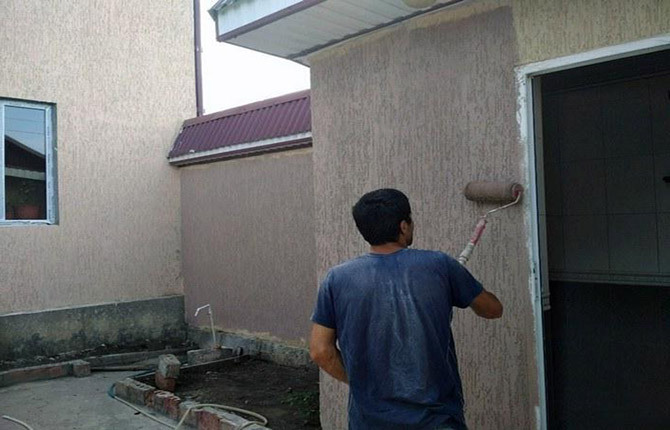
- By using different shades, you get a beautiful wall decoration.
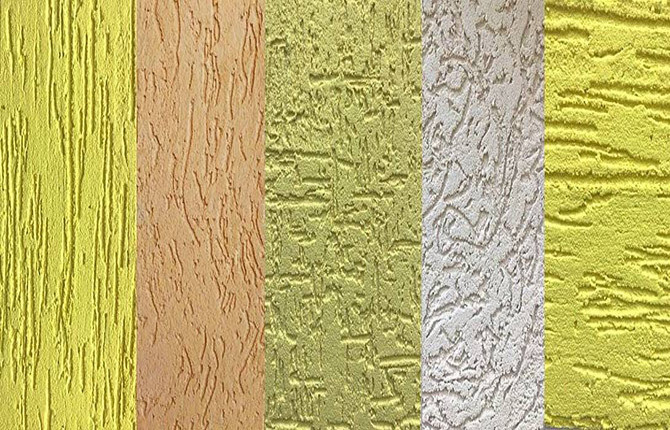
- An interesting decor is obtained if two-stage coloring is practiced. First, apply the coloring composition evenly, filling the grooves. When the surface is dry, use a darker or lighter paint. Apply it in the same color as the first layer of coating or make it in a different color. Apply with a semi-dry roller only to protruding parts of the relief. With this method, the illusion of volumetric coverage is obtained.
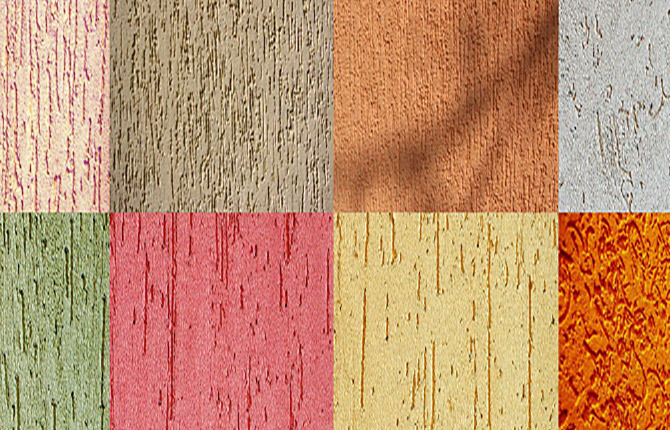
- You can add color to the paint for application along the protrusions or, conversely, along the recesses with reflective characteristics that enhance the perception of the depth of the finish.
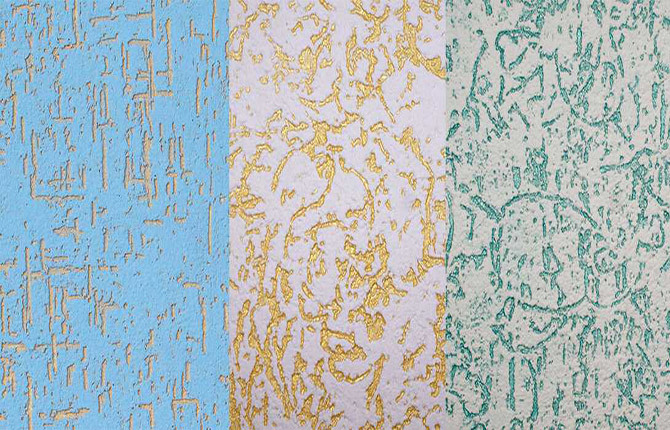
- A substitute for painting is glazing the decorative relief of the bark beetle with varnish, into which the desired color tone is introduced. Fill the entire plane with this composition, including grooves and all recesses. The deep shade of the finished coating is obtained with an interesting mysterious shine.
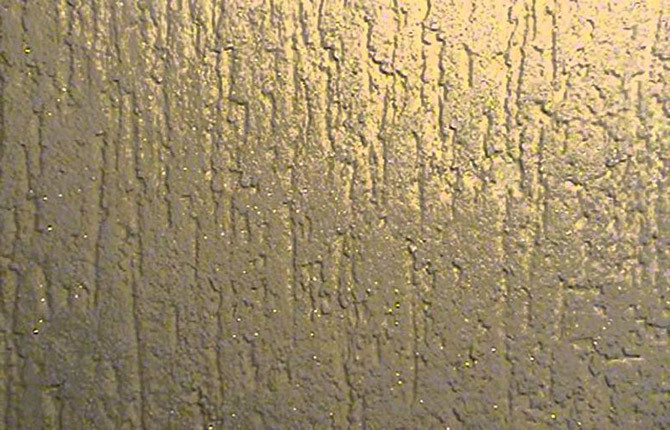
You can use transparent decorative varnish to cover painted dried plaster made using the bark beetle technique.
Plaster consumption
When purchasing decorative types of plaster, study the instructions. In it, the manufacturer indicates the grain size of the solid fraction, which determines the thickness of the layer, and the average consumption of the mixture (2.5–3.5 kg/sq. m).
For example, if you plan to apply a bark beetle mixture to a wall of 50 square meters. m at a flow rate of 2.5 kg/sq. m (when applying a layer of 1.5 cm), you will need:
2.5 x 50 = 125 kg.
If the finished composition is purchased in cans weighing 12 kg, then you will need 125 / 12 = 10.42 pcs.
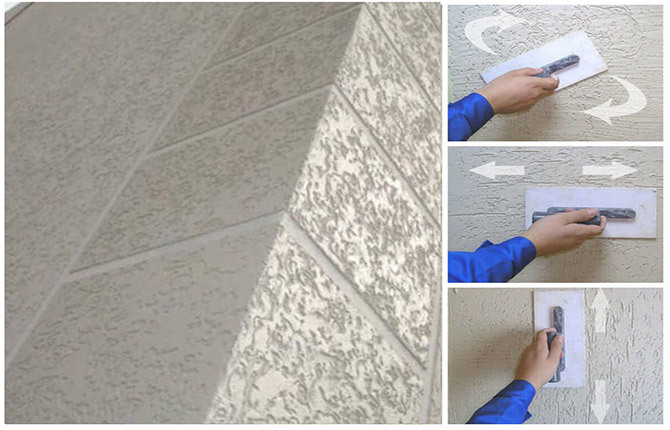
This means you need to buy 11 cans.
Main mistakes when applying bark beetle
It is important to follow the instructions, which indicate how to properly apply the plaster to obtain a decorative “bark beetle” coating.
If recommendations are not followed, the following errors are more common:
- The prepared solution is poorly applied to the wall, not providing the necessary adhesion. The reason is a violation of proportions.
- It is not possible to obtain an even decorative layer of plaster. This problem occurs if the wall was not prepared correctly.
- The “bark beetle” texture does not work out. A negative impact in such a situation is caused by the wrong choice of plaster and lack of skills in working with a trowel to obtain a characteristic relief pattern.
Beginning craftsmen often do not take into account the temperature and humidity of the surrounding atmosphere. Violations occur when working with long-drying mineral plaster on facades when the advice to cover it from the sun with film is ignored.
It is possible to apply decorative bark beetle plaster to the walls of buildings outside and inside. If the recommendations are followed correctly, an interesting relief coating will be obtained. Have you worked with such finishing material? If you are interested in the information obtained from the article, share it on social networks with your friends and bookmark it.

